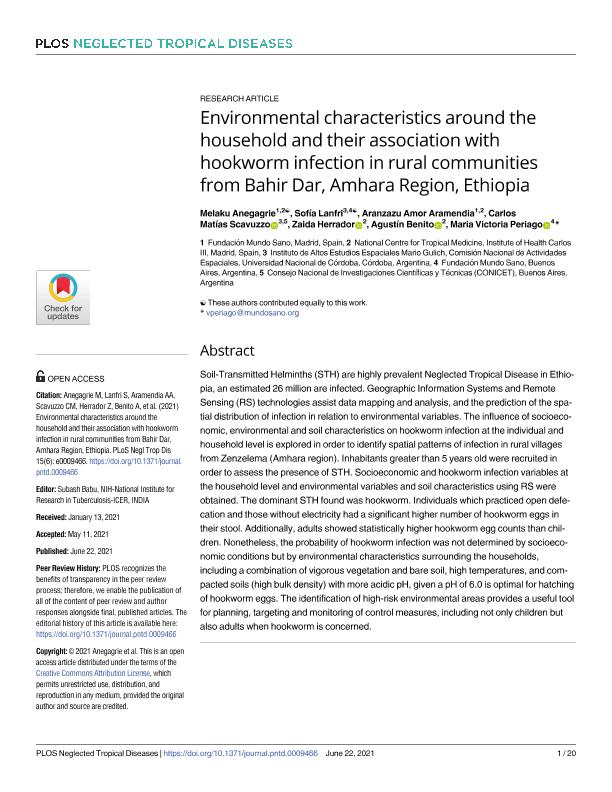Mostrar el registro sencillo del ítem
dc.contributor.author
Anegagrie, Melaku
dc.contributor.author
Lanfri, Sofía

dc.contributor.author
Aramendia, Aranzazu Amor
dc.contributor.author
Scavuzzo, Carlos Matias

dc.contributor.author
Herrador, Zaida
dc.contributor.author
Benito, Agustín
dc.contributor.author
Periago, Maria Victoria

dc.date.available
2022-05-23T23:09:16Z
dc.date.issued
2021-06-22
dc.identifier.citation
Anegagrie, Melaku; Lanfri, Sofía; Aramendia, Aranzazu Amor; Scavuzzo, Carlos Matias; Herrador, Zaida; et al.; Environmental characteristics around the household and their association with hookworm infection in rural communities from Bahir Dar, Amhara Region, Ethiopia; Public Library of Science; Neglected Tropical Diseases; 15; 6; 22-6-2021; 1-20
dc.identifier.issn
1935-2727
dc.identifier.uri
http://hdl.handle.net/11336/158064
dc.description.abstract
Soil-Transmitted Helminths (STH) are highly prevalent Neglected Tropical Disease in Ethiopia, an estimated 26 million are infected. Geographic Information Systems and Remote Sensing (RS) technologies assist data mapping and analysis, and the prediction of the spatial distribution of infection in relation to environmental variables. The influence of socioeconomic, environmental and soil characteristics on hookworm infection at the individual and household level is explored in order to identify spatial patterns of infection in rural villages from Zenzelema (Amhara region). Inhabitants greater than 5 years old were recruited in order to assess the presence of STH. Socioeconomic and hookworm infection variables at the household level and environmental variables and soil characteristics using RS were obtained. The dominant STH found was hookworm. Individuals which practiced open defecation and those without electricity had a significant higher number of hookworm eggs in their stool. Additionally, adults showed statistically higher hookworm egg counts than children. Nonetheless, the probability of hookworm infection was not determined by socioeconomic conditions but by environmental characteristics surrounding the households, including a combination of vigorous vegetation and bare soil, high temperatures, and compacted soils (high bulk density) with more acidic pH, given a pH of 6.0 is optimal for hatching of hookworm eggs. The identification of high-risk environmental areas provides a useful tool for planning, targeting and monitoring of control measures, including not only children but also adults when hookworm is concerned.
dc.format
application/pdf
dc.language.iso
eng
dc.publisher
Public Library of Science

dc.rights
info:eu-repo/semantics/openAccess
dc.rights.uri
https://creativecommons.org/licenses/by/2.5/ar/
dc.subject
HOOKWORMS
dc.subject
ENVIRONMENTAL CHARACTERISTICS
dc.subject
SOCIOECONOMIC CHARACTERISTICS
dc.subject
SOIL-TRANSMITTED HELMINTHS
dc.subject.classification
Otras Ciencias Médicas

dc.subject.classification
Otras Ciencias Médicas

dc.subject.classification
CIENCIAS MÉDICAS Y DE LA SALUD

dc.title
Environmental characteristics around the household and their association with hookworm infection in rural communities from Bahir Dar, Amhara Region, Ethiopia
dc.type
info:eu-repo/semantics/article
dc.type
info:ar-repo/semantics/artículo
dc.type
info:eu-repo/semantics/publishedVersion
dc.date.updated
2022-05-12T16:49:31Z
dc.identifier.eissn
1935-2735
dc.journal.volume
15
dc.journal.number
6
dc.journal.pagination
1-20
dc.journal.pais
Estados Unidos

dc.journal.ciudad
San Francisco
dc.description.fil
Fil: Anegagrie, Melaku. Fundación Mundo Sano; España. Instituto de Salud Carlos III; España
dc.description.fil
Fil: Lanfri, Sofía. Fundación Mundo Sano; Argentina. Comisión Nacional de Actividades Espaciales. Instituto de Altos Estudios Espaciales "Mario Gulich"; Argentina. Consejo Nacional de Investigaciones Científicas y Técnicas. Centro Científico Tecnológico Conicet - Córdoba; Argentina
dc.description.fil
Fil: Aramendia, Aranzazu Amor. Fundación Mundo Sano; España. Instituto de Salud Carlos III; España
dc.description.fil
Fil: Scavuzzo, Carlos Matias. Fundación Mundo Sano; Argentina. Comision Nacional de Actividades Espaciales. Instituto de Altos Estudios Espaciales "Mario Gulich"; Argentina. Consejo Nacional de Investigaciones Científicas y Técnicas. Centro Científico Tecnológico Conicet - Córdoba; Argentina
dc.description.fil
Fil: Herrador, Zaida. Instituto de Salud Carlos III; España
dc.description.fil
Fil: Benito, Agustín. Instituto de Salud Carlos III; España
dc.description.fil
Fil: Periago, Maria Victoria. Fundación Mundo Sano; Argentina
dc.journal.title
Neglected Tropical Diseases

dc.relation.alternativeid
info:eu-repo/semantics/altIdentifier/url/https://journals.plos.org/plosntds/article?id=10.1371/journal.pntd.0009466
dc.relation.alternativeid
info:eu-repo/semantics/altIdentifier/doi/http://dx.doi.org/10.1371/journal.pntd.0009466
Archivos asociados
